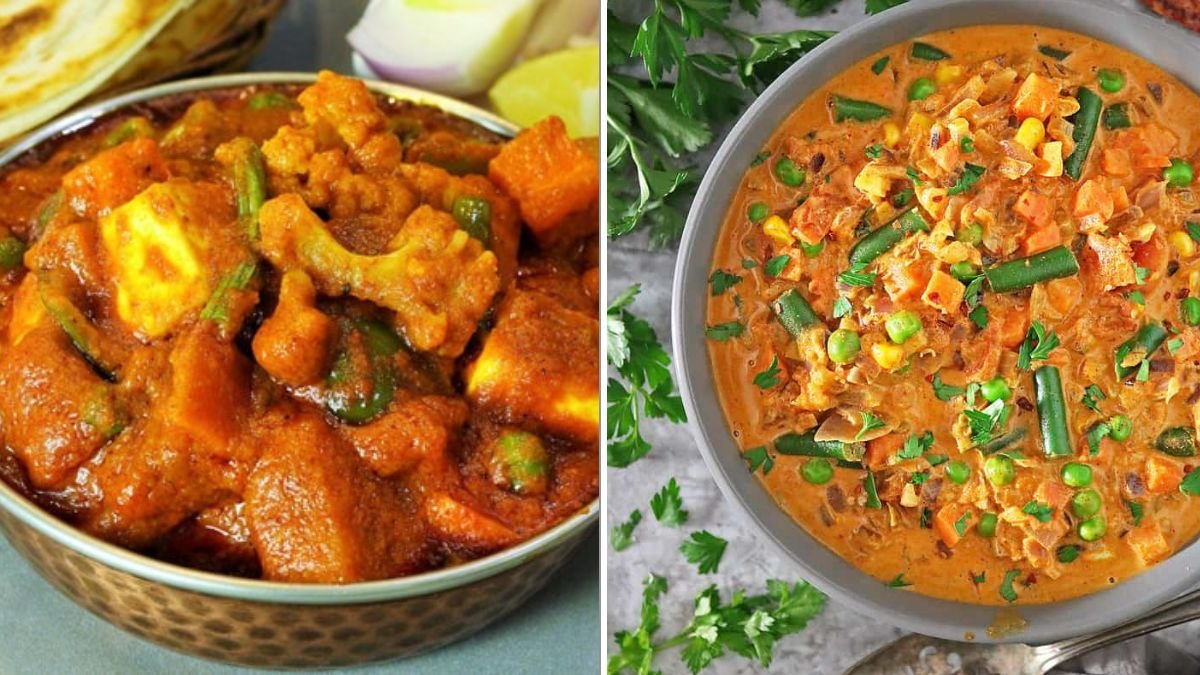A vibrant mix of flavors, textures, and aromas — Mixed Vegetable Curry is a timeless Indian dish that celebrates the beauty of seasonal produce. Whether served with rice, roti, or paratha, this curry is healthy, wholesome, and bursting with spice. The best part? You can prepare it at home in just 5 easy steps using simple ingredients.
This guide will walk you through everything — from choosing vegetables to cooking them perfectly — so you can enjoy a flavorful curry that tastes straight out of a restaurant.
Step 1: Gather and Prepare the Ingredients
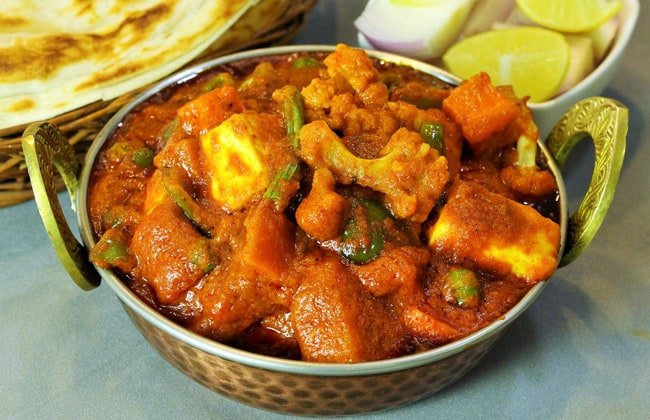
The foundation of any great curry lies in fresh ingredients. Begin by collecting a colorful variety of vegetables — ideally a mix of firm and soft ones for texture balance.
Commonly Used Vegetables:
- 1 cup carrots (diced)
- 1 cup potatoes (peeled and cubed)
- 1 cup green beans (cut into 1-inch pieces)
- ½ cup green peas (fresh or frozen)
- 1 cup cauliflower florets
- ½ cup capsicum (bell pepper, diced)
For the Curry Base:
- 2 medium onions (finely chopped)
- 2 medium tomatoes (pureed)
- 1 tablespoon ginger-garlic paste
- 2 tablespoons oil or ghee
- 1 teaspoon cumin seeds
- ½ teaspoon mustard seeds
- ¼ teaspoon asafoetida (hing)
- 1 teaspoon turmeric powder
- 1 teaspoon red chili powder
- 1½ teaspoons coriander powder
- 1 teaspoon cumin powder
- Salt to taste
- 1 teaspoon garam masala
- 2 cups water (adjust consistency)
- Fresh coriander leaves for garnish
Optional Additions:
- 2 tablespoons yogurt or coconut milk for a creamier texture
- 1 teaspoon kasuri methi (dried fenugreek leaves) for restaurant-style flavor
Prep Tip: Chop all the vegetables into even-sized pieces. This ensures they cook evenly without becoming mushy.
Step 2: Parboil the Vegetables
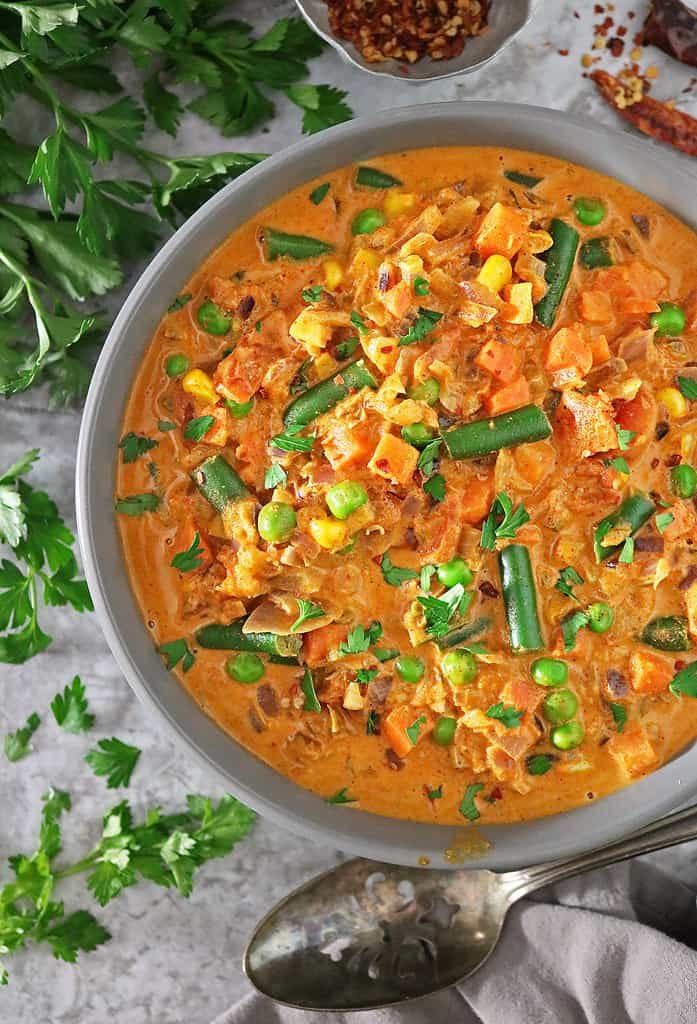
Cooking mixed vegetables directly in curry can lead to uneven texture — some turn mushy while others stay undercooked. The solution is parboiling.
- Boil 4 cups of water in a pot.
- Add the harder vegetables first — potatoes, carrots, beans, and cauliflower.
- Add a pinch of salt and cook for about 5–6 minutes until just tender.
- Drain and set aside immediately.
Tip: Don’t overcook. The vegetables will cook further in the curry base, and overboiling can make them lose flavor and structure.
Step 3: Prepare the Curry Base (Masala)
The masala is what gives this curry its depth and soul. You’ll want to build it slowly to bring out each spice’s aroma.
- Heat oil or ghee in a deep pan or kadhai.
- Add cumin seeds and mustard seeds. Once they splutter, add a pinch of asafoetida.
- Add chopped onions and sauté until golden brown.
- Stir in ginger-garlic paste and cook until the raw smell disappears.
- Add tomato puree and cook for 3–4 minutes until the oil begins to separate.
- Mix in turmeric, red chili, coriander, and cumin powder. Stir continuously to avoid burning the spices.
This forms your aromatic base — thick, rich, and full of flavor.
Optional Creamy Version: Whisk in 2 tablespoons of yogurt or coconut milk after adding the dry spices for a smoother, slightly richer curry.
Step 4: Combine Vegetables and Simmer
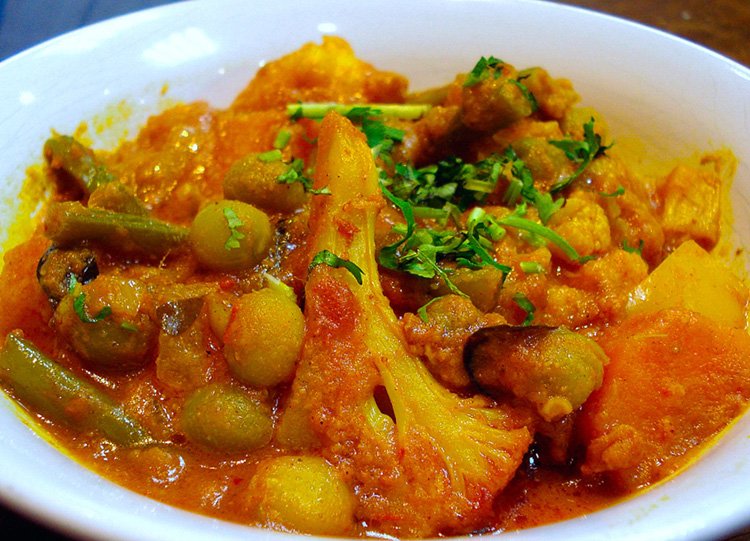
Now comes the most satisfying step — merging the veggies with the flavorful masala.
- Add the parboiled vegetables to the masala and stir well so they’re coated evenly.
- Pour in 1½ to 2 cups of water to reach your desired consistency.
- Add salt to taste and bring the curry to a gentle boil.
- Lower the heat, cover, and let it simmer for 10–12 minutes.
During this time, the vegetables absorb the spices while the gravy thickens naturally. Stir occasionally to prevent sticking.
Pro Tip: To make the curry thicker without adding cream, mash a few potato pieces with the back of a spoon into the sauce. It naturally enhances texture and richness.
Step 5: Add Final Touches and Serve
As your kitchen fills with the aroma of spices, it’s time for the finishing touches.
- Sprinkle garam masala and crushed kasuri methi.
- Mix gently and simmer for another 2 minutes.
- Turn off the heat and let it rest for 5 minutes before serving.
- Garnish with freshly chopped coriander leaves.
Serving Suggestions:
- Enjoy with soft chapatis, parathas, or naan.
- Serve alongside jeera rice, plain steamed rice, or brown rice for a wholesome meal.
- Pair with cucumber raita and papad for an authentic Indian dining experience.
Bonus Tips for a Perfect Mixed Vegetable Curry
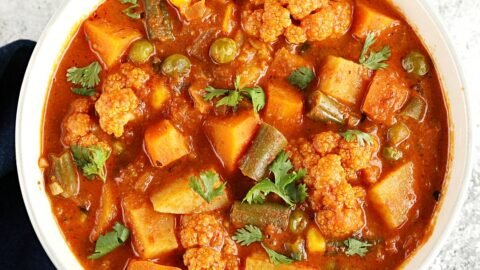
- Use seasonal veggies: Fresh, local vegetables add the best flavor and nutrition.
- Control spice levels: Adjust chili and garam masala to your comfort level.
- For vegan version: Skip yogurt and use coconut milk or cashew paste.
- Add tang: A splash of lemon juice or a spoon of tamarind pulp adds brightness.
- Batch cook: The curry tastes even better the next day as the spices deepen overnight.
Nutritional Benefits
This curry is more than just delicious — it’s a powerhouse of nutrients.
- Carrots: Rich in beta-carotene, great for skin and vision.
- Beans: Loaded with fiber and plant protein.
- Cauliflower: Full of antioxidants and vitamins.
- Peas: Provide protein and iron.
- Potatoes: Add energy and body to the curry.
- Capsicum: Boosts vitamin C and color appeal.
It’s a balanced meal — low in fat, high in vitamins, and naturally gluten-free.
Regional Variations to Try
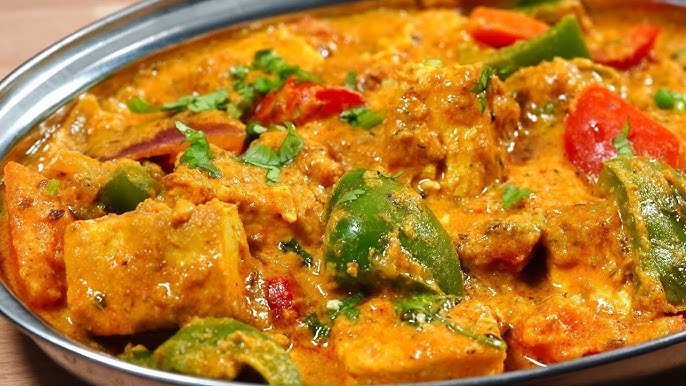
- North Indian Style: Add butter, cream, and kasuri methi for a dhaba-like richness.
- South Indian Style: Temper with curry leaves and mustard seeds, and add coconut milk.
- Gujarati Style: Add a pinch of jaggery and tamarind for a sweet-tangy twist.
- Maharashtrian Style: Include roasted peanut powder and goda masala for a rustic flavor.
Each regional touch gives this curry a new personality — feel free to experiment!
Final Thoughts
Cooking a Mixed Vegetable Curry at home is about more than following a recipe — it’s about creativity, freshness, and comfort. With just a few basic ingredients and these 5 easy steps, you can create a dish that’s bursting with color, flavor, and warmth.
From the sizzling of cumin seeds to the final sprinkle of coriander, every moment of cooking this curry brings joy. So the next time you crave something wholesome yet exciting, skip the takeout and make this Mixed Vegetable Curry yourself — healthy, hearty, and full of love in every bite.
